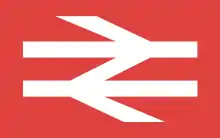British Rail Double Arrow
The British Rail Double Arrow, now officially known as the National Rail Double Arrow, is a logo that was created for British Rail, the then state-owned operator of Britain's railway network, in 1965. It is now used as part of the National Rail brand used for Britain's passenger rail services. As such it is still printed on railway tickets and used to denote railway stations, including usage on street signs pointing to such stations. The logo is, and always has been, used in a variety of colours, and in both positive and reversed forms.[1][2]

The logo grew out of a desire for modernisation in the 1960s, with the management of what was then known as British Railways wanting to divest the organisation of older motifs and develop a corporate identity to rival that of London Transport. BR's design panel set up a working party led by Milner Gray of the Design Research Unit. They drew up a Corporate Identity Manual which established a coherent brand and design standard for the whole organisation, specifying Rail Blue and pearl grey as the standard colour scheme for all rolling stock; Rail Alphabet as the standard corporate typeface, designed by Jock Kinneir and Margaret Calvert; and introducing the now-iconic corporate identity symbol of the "Double Arrow" logo. Designed by Gerald Barney (also of the DRU), this arrow device was formed of two interlocked arrows across two parallel lines, symbolising a double track railway. The new BR corporate identity and Double Arrow were rolled out in 1965, and the brand name of the organisation was truncated to "British Rail".[3][4]
The logo was used widely by British Rail on trains, stations and tickets. It was also by subsidiary companies, most notably on Sealink ferry funnels, where the standard image was used on the starboard side, but a mirror image on the port side. With the privatisation of the railways in the mid-1990s, the trademark registration for the logo was transferred to the Secretary of State for Transport. As British railway trains are now operated by a number of independent train operating companies, the double arrow logo no longer appears on railway vehicles except those preserved. However it still appears on railway tickets, which can usually be used on the services of a variety of train operators, and is used to denote stations within the National Rail network.[1][3][4][5]
References
- "Using the double arrow symbol" (PDF). National Rail. Retrieved 18 November 2020.
- Her Majesty's Government (2002). "The Traffic Signs Regulations and General Directions 2002 (SI 2002:3113)". Archived from the original on 19 April 2009. Retrieved 27 March 2009.
- Jackson, Tanya (2013). "6: In Search of an Identity". British Railways: The Nation's Railway. Stroud: The History Press. ISBN 978-0-7524-9742-6. Retrieved 11 September 2015.CS1 maint: ref=harv (link)
- Height, Frank; Cresswell, Roy (1979). Design for Passenger Transport. Pergamon. p. 118. ISBN 978-1-4831-5309-4. Retrieved 11 September 2015.CS1 maint: ref=harv (link)
- "Trade mark number EU001733575". Intellectual Property Office. Retrieved 18 November 2020.